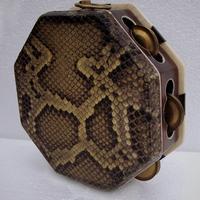bajiaogu overview
 The octagonal drum (pinyin: bā jiǎo gǔ) is a kind of slap-membrane musical instrument used by the Manchu people for self-entertainment in ancient times. The drum body is flat and small, and the drum surface is octagonal, representing the Eight Banners of the Qing Dynasty at that time. The drum frame is made of eight pieces of ebony, red sandalwood, mahogany, rosewood and bone pieces; it is said that the leaders of the Eight Banners each offered a piece of the best wood inlay. Two to three small copper cymbals are embedded in each of the seven sides of the frame, and one side is inlaid with studs and drum spikes, implying the abundance of grains. It is a traditional form of folk art that is popular among the people.
The octagonal drum (pinyin: bā jiǎo gǔ) is a kind of slap-membrane musical instrument used by the Manchu people for self-entertainment in ancient times. The drum body is flat and small, and the drum surface is octagonal, representing the Eight Banners of the Qing Dynasty at that time. The drum frame is made of eight pieces of ebony, red sandalwood, mahogany, rosewood and bone pieces; it is said that the leaders of the Eight Banners each offered a piece of the best wood inlay. Two to three small copper cymbals are embedded in each of the seven sides of the frame, and one side is inlaid with studs and drum spikes, implying the abundance of grains. It is a traditional form of folk art that is popular among the people.Octagonal drum, octagonal body, wooden frame, about 17 cm in diameter, one side covered with python skin, copper cymbals embedded around the drum body, and decorated with silk tassels, the drum shape is small and exquisite. When playing, you can hit the drum head with a fingerstyle to make a crisp sound, and shake the drum body or rub the drum head to make a pleasant cymbal sound. The Manchu octagonal drum is mainly spread in the Xincheng District of Hohhot City, North China and Northeast China. In the 1950s and 1960s, with the support of the government, through the excavation and arrangement of old folk artists in our district, on the basis of traditional singing and repertoire, it gradually developed from folk art to a local opera. The types of local operas are very prosperous in history and are widely popular.
The octagonal drum opera incorporates many regional artistic elements, forming a unique style and artistic characteristics. Its diversity is influenced by the spread of regional folk culture. With its profound cultural penetration, it has become a popular art form among the people.
The early octagonal drum originated from Guanwai and spread in Guannei. It was a folk musical instrument used by the Manchu people when they lived outside Guan. joy. After entering the customs, in the garrison or on the way of the march, they often beat drums and sing to their heart's content to relieve fatigue. The octagonal drum has a history of more than 200 years. In the fourth year of Emperor Qianlong's reign (1739), the Qing government built Suiyuan City (now Hohhot New City). The Manchu Eight Banners officers and soldiers who live here often sing with drums in their spare time, and integrate the anecdotes and daily life around them into their lyrics and compose and sing their own songs. The Eight Banners also used it to beat the drums when they sang the song of triumph. Therefore, the octagonal drum was introduced into the Hohhot area with the Qing Manchu bannermen stationed in the frontier fortresses and spread. During the reign of Qianlong in the Qing Dynasty, singing flourished for a time, and it was once called Taiping Song. At the beginning of the Republic of China, the Manchu descendants in Suiyuan City often organized the box office, composed lyrics and sang. At this time, the octagonal drum art was continuously absorbed and enriched, and it has become a fashionable art in the city. After the Japanese invaders invaded Suiyuan, the performance of the octagonal drum music performance declined day by day.
- Pinyin:bā jiǎo gǔ
- nationality:Manchu
- type:Membrane musical instrument
overview of other similar instruments
- sanyanxiao overview
- Daguangxian overview
- Leiqin overview
- hahao overview
- yandundagu overview
- Han Xiaozheng overview
- Fang Xiang overview
- guanzi overview
- zhuqin (Dao Qin) overview
- zhuiqin overview
- bangzi overview
- three-stringed piano overview
- Gehu overview
- xiao overview
- xiaokonghou overview
- Konghou overview
- Sheng overview
- suona overview
- hulusi overview
- gushao overview
 渝公网安备 50010702504639号
渝公网安备 50010702504639号